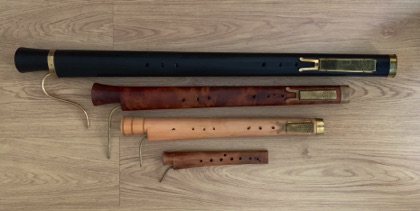Cornetto:
Carved from two halves of wood, shaped and bound together with linen tread and parchment, the cornett uses a small mouthpiece like a brass instrument to produce its sound. It was most popular during the renaissance and early baroque periods.
Various sizes and types are pictured including: treble, alto, cornettino, straight and mute.
Many of these I made myself, however I own several by other makers such as: Andrew Hallock, Roland Wilson, Paolo Fanciullacci, Serge Delmas and Henri Gohin.


Natural Trumpet & Slide Trumpet:
The top trumpet has a slide within the first tube making it (more or less) chromatic from g below the stave up to the top. Depending on the choice of mouthpiece it can be used in the bottom register as an alto instrument in a 16th century wind band or as a tromba tirasi for the demanding works of J. S. Bach.
The bottom trumpet can be used either as an unvented natural trumpet or with modern vent holes.
Both trumpets were made by myself and Nicholas Perry.

Historical Bagpipes:
Bagpipes have a long history before the well known Highland pipes. The pipes I use most often are pictured. At the top some 'English' double pipes, made by myself after a carving in Broad Chalke, Dorset. With two chanters and single reeds this pipe has a light buzzy sound and the ability to play in harmony! Clip below.
In the middle are some border pipes by Jon Swayne - a typical pan european pipe similar to many period images. At the Bottom is a spanish gaita gallega. This pipe shares many of its attributes with pipes in medieval images.

Shawm / Pommer:
Turned on a lathe with a conical bore the shawm is played with a double reed producing a loud sound. A popular instrument in the medieval to renaissance periods where it became the most prominent wind instrument in many countries. It was developed into the oboe.
The sizes here are the tenor (extended down to G), Niccolo tenor (down to low C), two altos in G and soprano in D .
These instruments are made by Gunter Korber, John Hanchett, Fritz Heller, Jim Parr and Paul Hailperin.
Recorders:
These 'renaissance' instruments have a much wider bore than their baroque counterparts. The three sizes pictured here are, soprano, alto and tenor.
My recorders are made by Tim Cranmore



Curtal / Dulcian
The curtal is the forerunner of the bassoon. It has two bores which run down and up the body meaning it is half as long as its sounding length. Shown here are the bass, tenor, alto and soprano.
These are made by Eric Moulder, Graham Lyndon-Jones and Fritz Heller.